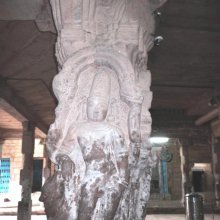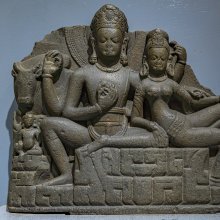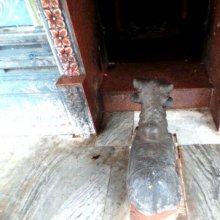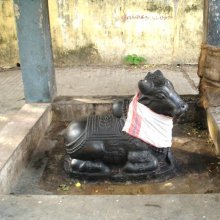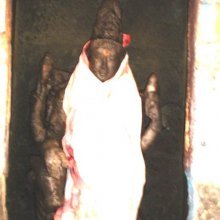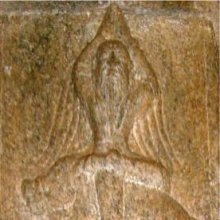Nanti, Nānti: 3 definitions
Introduction:
Nanti means something in the history of ancient India, biology, Tamil. If you want to know the exact meaning, history, etymology or English translation of this term then check out the descriptions on this page. Add your comment or reference to a book if you want to contribute to this summary article.
Images (photo gallery)
(+23 more images available)
India history and geography
Source: Institut Français de Pondichéry: The Shaivite legends of KanchipuramNanti (நந்தி) (in Tamil) refers to Nandin in Sanskrit, and represents one of the proper nouns mentioned in the Kanchipuranam, which narrates the Shaivite Legends of Kanchipuram—an ancient and sacred district in Tamil Nadu (India). The Kanchipuranam (mentioning Nanti) reminds us that Kanchipuram represents an important seat of Hinduism where Vaishnavism and Shaivism have co-existed since ancient times.

The history of India traces the identification of countries, villages, towns and other regions of India, as well as mythology, zoology, royal dynasties, rulers, tribes, local festivities and traditions and regional languages. Ancient India enjoyed religious freedom and encourages the path of Dharma, a concept common to Buddhism, Hinduism, and Jainism.
Biology (plants and animals)
Source: Google Books: CRC World Dictionary (Regional names)1) Nanti in India is the name of a plant defined with Acalypha fruticosa in various botanical sources. This page contains potential references in Ayurveda, modern medicine, and other folk traditions or local practices It has the synonym Ricinocarpus fruticosus (Forssk.) Kuntze.
2) Nanti is also identified with Toona ciliata It has the synonym Cedrela australis F. Muell., nom. illeg. (etc.).
Example references for further research on medicinal uses or toxicity (see latin names for full list):
· Familiarum Naturalium Regni Vegetabilis Monographicae (1846)
· Adansonia (1861)
· Fragmenta Phytographiae Australiae (Mueller) (1858)
· Evidence-based complementary and alternative medicine: eCAM (2009)
· Austral. Syst. Bot. Soc. Newsl. (1992)
· The family Euphorbiaceae in India. (2007)
If you are looking for specific details regarding Nanti, for example diet and recipes, health benefits, extract dosage, chemical composition, side effects, pregnancy safety, have a look at these references.

This sections includes definitions from the five kingdoms of living things: Animals, Plants, Fungi, Protists and Monera. It will include both the official binomial nomenclature (scientific names usually in Latin) as well as regional spellings and variants.
Languages of India and abroad
Tamil dictionary
Source: DDSA: University of Madras: Tamil LexiconNanti (நந்தி) noun < nandi.
1. Bull; இடபம். (பிங்கலகண்டு) [idapam. (pingalagandu)]
2. Nandi, chief attendant of Śiva, having a bull’s face; சிவகணநாதராகிய நந்திதேவர். (சூடாமணிநிகண்டு) நங்கணாதனா நந்தி தவஞ்செய்து [sivagananatharagiya nanthithevar. (sudamaninigandu) nanganathana nanthi thavancheythu] (பெரியபுராணம் வைத்திய மலையகராதி [periyapuranam vaithiya malaiyagarathi] 35).
3. Taurus in the zodiac; இடபராசி. (யாழ்ப்பாணத்து மானிப்பாயகராதி) [idaparasi. (yazhppanathu manippayagarathi)]
4. Śiva; சிவன். (பிங்கலகண்டு) நந்தி மகன் றனை ஞானக்கொழுந்தினை [sivan. (pingalagandu) nanthi magan ranai gnanakkozhunthinai] (திருமந். [thiruman.] 1).
5. Name of some Pallava kings; பல்லவ அரசர் சிலரின் பெயர். [pallava arasar silarin peyar.]
6. Nandidroog, a mountain in Mysore in which the Pālār takes its rise; மைசூர்ச்சீமையில் பாலாற் றின் பிறப்பிடமாகிய நந்திதுர்க்கம் என்னும் வைத்திய மலையகராதி நனை முடி நந்திக்குன்ற நளவெண்பாிபடப்பொழியுந் தெண்ணீர் [maisurchimaiyil palar rin pirappidamagiya nanthithurkkam ennum vaithiya malaiyagarathi nanai mudi nanthikkunra nalipadappozhiyun thennir] (காஞ்சிப்புராணம் நாட். [kanchippuranam nad.] 13).
7. A Jaina title; சமணர் பட்டபெயர். கனகநந்தியும் புட்நந்தியும் பவண நந்தியும் [samanar pattapeyar. kanagananthiyum pudnanthiyum pavana nanthiyum] (தேவாரம் [thevaram] 859, 6).
8. See நந்திநாகரம். பழமொழிு தறு நாகரநந்தி முதலிபியைப் பயின்றுவலான் [nanthinagaram. pazhu tharu nagarananthi muthalipiyaip payinruvalan] (சிவதருமோத்தரம் சிவஞானதா. [sivatharumotharam sivagnanatha.] 32).
9. A secondary Purāṇa, one of 18 upa-purāṇam, q.v.; ஓர் உபபுராணம். [or upapuranam.]
10. See நந்திக்கிராமம். நந்தியம் பதியிடை நாதன் [nanthikkiramam. nanthiyam pathiyidai nathan] (கம்பராமாயணம் கிளைகண்டு. [kambaramayanam kilaigandu.] 140).
11. See நந்தியாவட்டம். நந்தி நறவ நறும்புன்னாகம் [nanthiyavattam. nanthi narava narumbunnagam] (பத்துப்பாட்டு: குறிஞ்சிப்பாட்டு [pathuppattu: kurinchippattu] 91).
--- OR ---
Nanti (நந்தி) noun
1. Oil-monger; செக்கான். (பிங்கலகண்டு) [sekkan. (pingalagandu)]
2. A kind of drum; பேரிகை. (சூடாமணிநிகண்டு) [perigai. (sudamaninigandu)]
3. Common bastard cedar. See மதகரிவேம்பு. [mathagarivembu.]
4. Indian shrubby copper leaf. See சின்னி⁴. [sinni⁴.]
--- OR ---
Nanti (நந்தி) noun probably from நந்து¹-. [nanthu¹-.] Small, immature pumpkin; நன்றாக விளையாத சிறுபூசனிக் காய். [nanraga vilaiyatha sirupusanig kay.] Nāñ.
--- OR ---
Nānti (நாந்தி) noun < nāndī.
1. An invocatory verse, as in a drama; நாடகமுன்னுரை. [nadagamunnurai.]
2. Prologue; பாயிரம். இது . . . நாந்தி கூறுகின்றது [payiram. ithu . . . nanthi kuruginrathu] (பிரயோகவிவேகம் [pirayogavivegam] 3, உரை [urai]).
3. A Śrāddha ceremony performed to propitiate a class of manes before celebrating any auspicious event; கலி யாணம் முதலிய சுபகாரியங்கள் செய்வதற்குமுன் பிதிரருள் ஒருசாராரைத் திருத்திசெய்ய நடத்தும் சிராத்தவகை. [kali yanam muthaliya supagariyangal seyvatharkumun pithirarul orusararaith thiruthiseyya nadathum sirathavagai.]
--- OR ---
Nānti (நாந்தி) noun Back; முதுகு. [muthugu.] Local usage
Tamil is an ancient language of India from the Dravidian family spoken by roughly 250 million people mainly in southern India and Sri Lanka.
See also (Relevant definitions)
Starts with (+13): Namtike, Namtisu, Namtiti, Nantie, Nantikantaru, Nantikecan, Nantikeccuram, Nantikkalampakam, Nantikkiramam, Nantikkol, Nantimukam, Nantinakaram, Nantini, Nantipattiri, Nantipemman, Nantipiran, Nantippucani, Nantippucanikkoti, Nantippucini, Nantipura.
Ends with: Ananti, Arjavinanti, Atikarananti, Banamti, Civananti, Inamti, Jananti, Jariinamti, Kakananti, Kanananti, Komananti, Mayilainanti, Minanti, Nakananti, Parananti, Prananti, Vananti, Vinanti.
Full-text (+221): Nandi, Nandikeshvara, Nantitevan, Nandipurana, Nandivriksha, Nandidharma, Nandishvara, Nantipattiri, Nantikkalampakam, Nandivardhana, Nantipemman, Nantimukam, Nantivirutcam, Velli-varaikappon, Nandigupta, Nandishena, Nandigrama, Nandighosha, Sandhyabali, Vitaimukan.
Relevant text
Search found 97 books and stories containing Nanti, Nandi, Nānti, Nanthi, Naanthi; (plurals include: Nantis, Nandis, Nāntis, Nanthis, Naanthis). You can also click to the full overview containing English textual excerpts. Below are direct links for the most relevant articles:
The Religion and Philosophy of Tevaram (Thevaram) (by M. A. Dorai Rangaswamy)
Nayanar 27: Nami Nandi Adigal (Naminanti Atikal) < [Volume 4.1.1 - A comparative study of the Shaivite saints the Thiruthondathogai]
Chapter 1.4 - Rishabharudha-murti (depiction of the Brahmani bull) < [Volume 2 - Nampi Arurar and Mythology]
Nayanar 30: Tirumular (Thirumoolar) or Tirumula < [Volume 4.1.1 - A comparative study of the Shaivite saints the Thiruthondathogai]
Middle Chola Temples (by S. R. Balasubrahmanyam)
Temples in Kulambandal < [Chapter IV - Temples of Rajendra I’s Time]
Mahamandapa and Mukhamandapa < [Tanjavur/Thanjavur (Rajarajesvaram temple)]
The Central Shrine < [Tanjavur/Thanjavur (Rajarajesvaram temple)]
Early Chola Temples (by S. R. Balasubrahmanyam)
Temples in Solapuram < [Chapter II - Temples of Parantaka I’s Time]
Ashta Parivara Devatas < [Chapter XIII - Prasada: Component Parts]
Kailasanathar Temple < [Chapter XIV - Conclusion]
Annadatri-carita (study) (by Sarannya V.)
2. Nandi Shloka (auspicious verse) < [Chapter 4 - Dramatic Appraisal of Annadatri-carita]
Three Different Accounts of the Origin of Adhikāranandin (Nandikeśvara)
Related products
